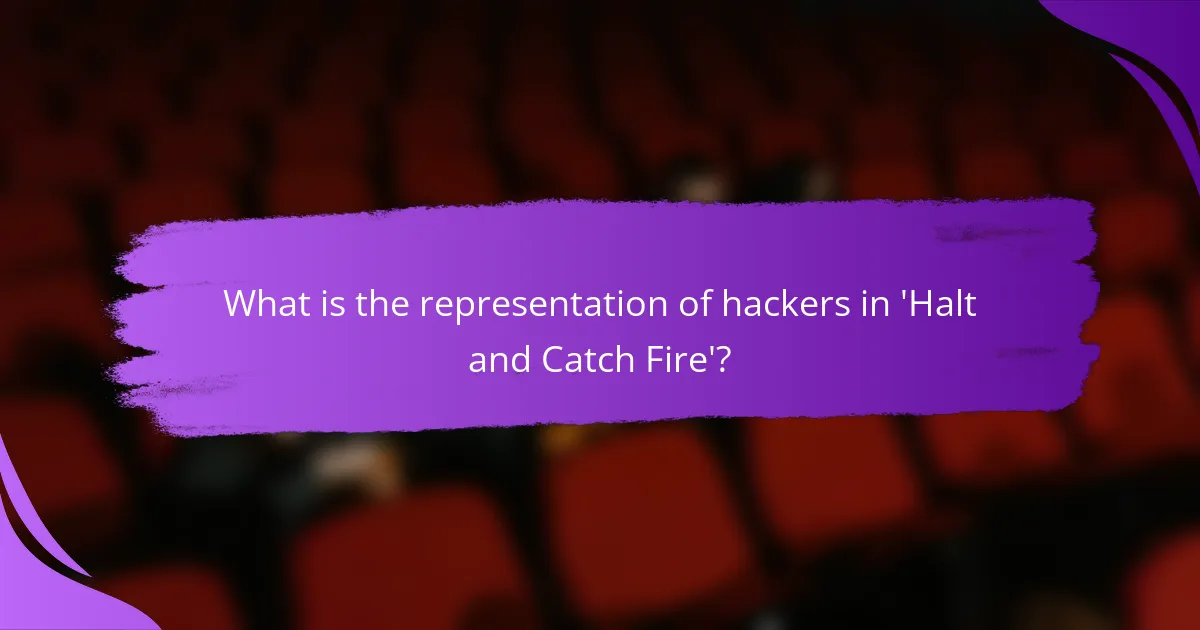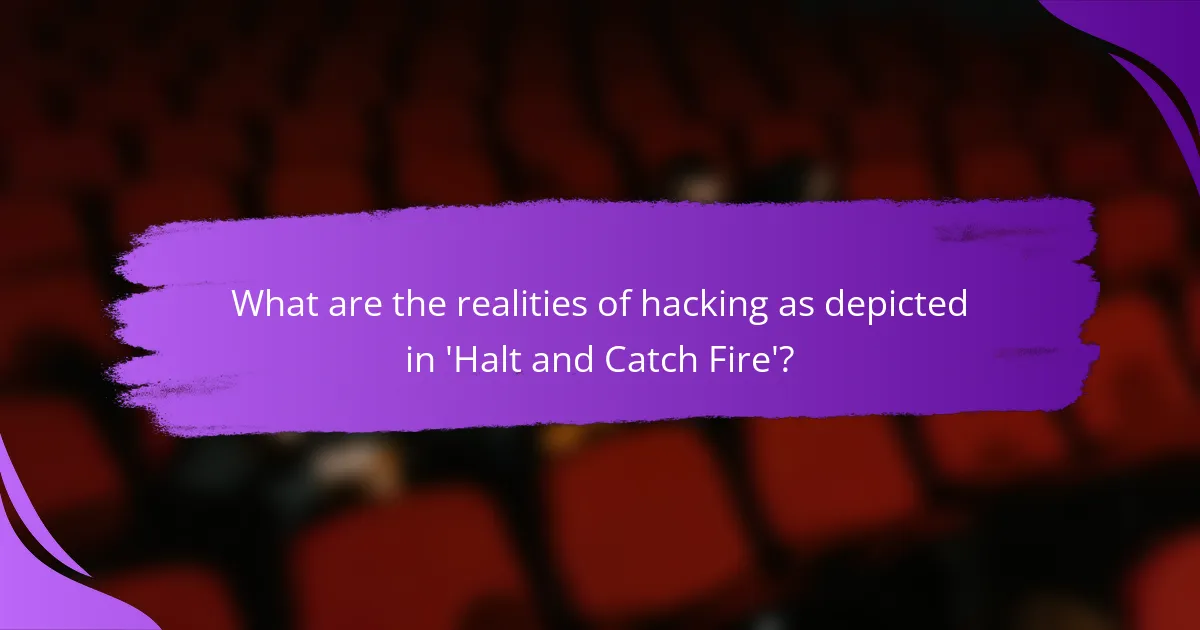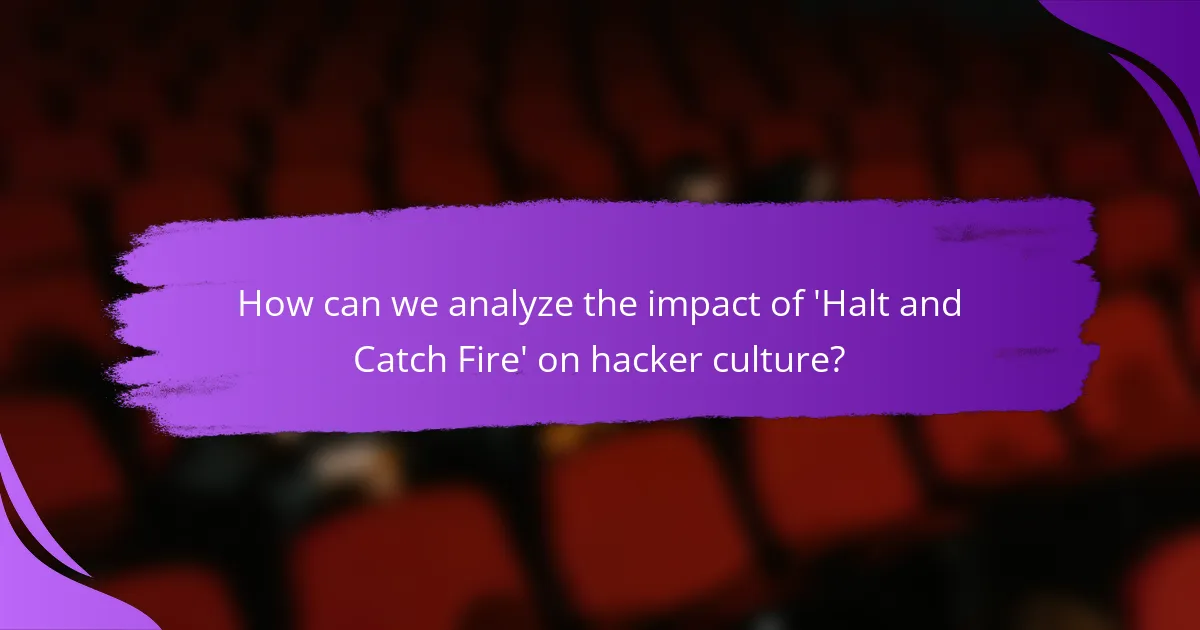The article examines the representation of hackers in the television series ‘Halt and Catch Fire,’ highlighting how the show presents hackers as innovative and resourceful individuals rather than merely malicious actors. It explores key characters, such as Cameron Howe, who embody the hacker ethos through their technical skills and rebellious spirit. The narrative addresses the ethical dilemmas faced by hackers, emphasizing their role in shaping the tech industry and the importance of collaboration within hacker culture. Additionally, the article discusses the impact of the series on public perception of hackers, considering themes of gender and diversity in the tech landscape. Overall, it provides a nuanced view of hacking that blends technical expertise with moral complexities.

What is the representation of hackers in ‘Halt and Catch Fire’?
The representation of hackers in ‘Halt and Catch Fire’ is multifaceted and nuanced. The series portrays hackers as innovative and resourceful individuals. They are shown as passionate about technology and driven by a desire to create and disrupt. Characters like Cameron Howe exemplify the hacker ethos, embodying both technical skill and rebellious spirit. The show contrasts traditional stereotypes of hackers as solely malicious actors. Instead, it highlights their role in shaping the tech industry and pushing boundaries. This representation aligns with the real-life emergence of hacker culture in the 1980s and 1990s. The series captures the complexity of their motivations and the ethical dilemmas they face. Overall, ‘Halt and Catch Fire’ presents hackers as both pioneers and flawed individuals navigating a rapidly changing landscape.
How does ‘Halt and Catch Fire’ portray the hacker culture?
‘Halt and Catch Fire’ portrays hacker culture as innovative yet ethically ambiguous. The series showcases characters who are driven by a desire to push technological boundaries. They often operate outside traditional corporate structures. This reflects a rebellious spirit commonly associated with hacker culture. The show highlights both the excitement and risks of hacking. Characters frequently engage in hacking to challenge norms and create new solutions. Their motivations include personal ambition and a quest for freedom in technology. This duality represents the real complexities of hacker culture.
What specific characteristics define the hackers in the series?
The hackers in the series exhibit intelligence, creativity, and a strong sense of ethics. They possess advanced technical skills, allowing them to manipulate systems effectively. Their problem-solving abilities are showcased through innovative solutions to complex challenges. Additionally, they often challenge societal norms, reflecting a rebellious spirit. The series portrays them as collaborative, valuing teamwork in achieving their goals. Their passion for technology drives their pursuits, often leading to personal sacrifices. The depiction also highlights their vulnerabilities, illustrating the impact of their choices on personal relationships. Overall, the hackers embody a multifaceted representation, blending stereotypes with realistic traits.
How do the hackers’ skills and motivations reflect real-life hacking culture?
Hackers’ skills and motivations mirror real-life hacking culture through their emphasis on problem-solving and creativity. These individuals often possess advanced technical abilities, enabling them to navigate and manipulate systems effectively. Their motivations vary from curiosity and the desire for knowledge to social activism and financial gain. For instance, many hackers engage in ethical hacking to expose vulnerabilities in systems, reflecting a commitment to improving security. Additionally, the culture values collaboration and sharing knowledge, as seen in open-source projects. This community-driven aspect fosters innovation and collective learning. Real-life examples include the rise of hacktivism, where hackers target organizations to promote social change. Such motivations and skills demonstrate the complex nature of hacking culture, blending technical expertise with ethical considerations.
What stereotypes about hackers are presented in ‘Halt and Catch Fire’?
‘Halt and Catch Fire’ presents several stereotypes about hackers. One stereotype is that hackers are socially awkward individuals. The characters often display a lack of social skills and struggle with personal relationships. Another stereotype is that hackers are male-dominated. The series predominantly features male hackers, reinforcing the notion that hacking is a male-centric field. Additionally, the show depicts hackers as rebels. They often challenge authority and corporate norms, which is a common trope in hacker narratives. Lastly, hackers are shown as genius-level intellects. The characters often possess extraordinary technical skills, suggesting that hacking requires exceptional intelligence. These stereotypes reflect broader societal perceptions of hackers, which can be both limiting and misleading.
Which common stereotypes are challenged or reinforced in the series?
The series “Halt and Catch Fire” challenges several common stereotypes about hackers. It portrays hackers as complex individuals rather than mere criminals or socially awkward geniuses. The characters exhibit a range of personalities and motivations, emphasizing their humanity. Female hackers are represented prominently, countering the stereotype that hacking is a male-dominated field. The series also explores the ethical dilemmas faced by hackers, highlighting their potential for positive contributions to technology. These nuanced portrayals provide a more balanced view of the hacker community, moving beyond simplistic stereotypes.
How do these stereotypes impact the audience’s perception of hackers?
Stereotypes significantly shape the audience’s perception of hackers. They often portray hackers as malicious or criminal figures. This portrayal creates fear and mistrust among the public. Consequently, audiences may overlook the positive contributions of ethical hackers. For instance, ethical hackers work to improve cybersecurity. They help organizations protect sensitive information. Research indicates that negative stereotypes can lead to stigmatization. This stigmatization affects how society views technology professionals. Overall, stereotypes can distort the understanding of the hacker community.

What are the realities of hacking as depicted in ‘Halt and Catch Fire’?
The realities of hacking in ‘Halt and Catch Fire’ highlight both technical skill and ethical dilemmas. Characters demonstrate advanced programming and problem-solving abilities. Hacking is portrayed as a means to innovate and disrupt traditional systems. However, the show also presents hacking as morally ambiguous. Characters face consequences for their actions, reflecting real-world legal implications. The narrative emphasizes collaboration among hackers rather than isolation. It showcases the community aspect of hacking, which contrasts with typical stereotypes. Overall, ‘Halt and Catch Fire’ presents a nuanced view of hacking that blends technical prowess with ethical complexities.
How does the show balance fiction and reality in its portrayal of hacking?
The show balances fiction and reality in its portrayal of hacking by integrating realistic technical details with dramatic storytelling. It features authentic programming languages and hacking techniques, which enhances credibility. For example, the characters use actual coding practices and tools that are relevant to the tech industry. This attention to detail reflects real-world hacking scenarios, making the narrative believable. At the same time, the show amplifies certain aspects for dramatic effect, such as the speed of hacking and the consequences of cyber actions. This blend creates a compelling narrative that resonates with both tech-savvy viewers and general audiences.
What real-life events or technologies influence the show’s narrative?
The show’s narrative is influenced by real-life events and technologies from the 1980s and 1990s. Key events include the rise of personal computing and the emergence of the Internet. The development of influential technologies like the IBM PC and Apple Macintosh plays a significant role. The portrayal of hacking culture reflects the actual hacker movements during this period. Events such as the launch of the World Wide Web are also crucial to the storyline. These historical milestones shape character motivations and plot developments. The show accurately depicts the competitive landscape of tech startups. This context provides authenticity to the characters’ experiences and challenges.
How accurate are the technical aspects of hacking shown in the series?
The technical aspects of hacking shown in the series are often dramatized and not entirely accurate. The series portrays hacking as a quick and easy process. In reality, hacking requires extensive knowledge and time. Many hacking techniques depicted oversimplify complex procedures. For example, social engineering is often glossed over. Real hackers spend significant time researching their targets. Additionally, the tools used in the series may not reflect actual software used by professionals. Experts have noted that the series prioritizes entertainment over realism. Overall, while some elements are based on real concepts, the accuracy is limited.
What are the social implications of hacker representation in media?
Hacker representation in media significantly influences societal perceptions of technology and security. Media often portrays hackers as either heroes or villains, shaping public opinion on cybersecurity issues. This duality can lead to a misunderstanding of the hacker community’s diversity. For example, the glorification of hacking can inspire innovation but may also encourage illegal activities. Studies show that negative portrayals can foster fear and distrust towards technology. Consequently, this impacts policy-making and public attitudes towards privacy and surveillance. Furthermore, hacker representation can affect young people’s career aspirations in technology fields. Overall, media representation shapes the narrative around hackers, influencing both societal norms and individual behavior.
How does ‘Halt and Catch Fire’ influence public understanding of hackers?
‘Halt and Catch Fire’ influences public understanding of hackers by humanizing them and showcasing their complexities. The series portrays hackers as innovative individuals driven by passion and creativity. This representation challenges the stereotype of hackers as solely malicious or criminal figures. Characters like Cameron Howe exemplify the struggles and triumphs of women in tech, broadening the narrative around hackers. The show illustrates the collaborative nature of hacking, emphasizing teamwork and problem-solving. By depicting the personal lives of hackers, it adds depth to their motivations. The series also highlights the ethical dilemmas faced in the tech industry. Overall, ‘Halt and Catch Fire’ reshapes perceptions by presenting hackers as multidimensional characters rather than one-dimensional villains.
What role does media representation play in shaping hacker identities?
Media representation significantly influences hacker identities by establishing societal perceptions and stereotypes. In various media, hackers are often depicted as either heroes or villains. This dichotomy shapes public understanding of hacker motivations and ethics. For instance, shows like ‘Halt and Catch Fire’ portray hackers as innovative and resourceful individuals. Such representations can inspire admiration for technical skills and creativity. Conversely, negative portrayals can lead to fear and misunderstanding of hacking as solely malicious. Research indicates that media narratives can impact real-world attitudes toward technology and cybersecurity. The portrayal of hackers in media thus plays a crucial role in constructing their identities within society.

How can we analyze the impact of ‘Halt and Catch Fire’ on hacker culture?
Analyzing the impact of ‘Halt and Catch Fire’ on hacker culture involves examining its portrayal of technology and innovation. The show highlights the rise of personal computing and the early internet. It presents characters who embody both the creativity and ethical dilemmas of hacking. This representation influences public perception of hackers, blending stereotypes with more nuanced realities. The series showcases collaboration and competition in tech development, reflecting real-world hacker culture dynamics. Additionally, it addresses issues of gender and diversity within the tech industry. By depicting these themes, ‘Halt and Catch Fire’ contributes to the ongoing conversation about the hacker ethos and its societal implications.
What lessons can be learned from the portrayal of hackers in the series?
The portrayal of hackers in the series teaches several important lessons. First, it highlights the complexity of hacker motivations. Hackers are often driven by curiosity, a desire for innovation, or a quest for social justice. This portrayal challenges the stereotype of hackers as solely malicious or criminal figures.
Second, the series emphasizes the ethical dilemmas faced by hackers. Characters navigate the fine line between right and wrong, showcasing the moral implications of their actions. This reflects real-world discussions about cybersecurity and privacy.
Third, the series illustrates the importance of collaboration in hacking culture. Hackers often work in teams, sharing knowledge and skills to achieve their goals. This underscores the value of community and support in technological advancements.
Finally, the series suggests that understanding technology requires critical thinking. Viewers learn that hacking is not just about technical skills but also about creative problem-solving. This encourages a broader understanding of technology’s impact on society.
How can viewers critically engage with the representations of hackers?
Viewers can critically engage with the representations of hackers by analyzing the narrative choices made in media. They should examine how hackers are portrayed in terms of stereotypes versus real-life behaviors. Viewers can compare fictional depictions to documented hacker activities and motivations. This includes understanding the ethical implications of hacking as shown in the series. Analyzing character development can reveal deeper societal messages about technology and privacy. Engaging with expert opinions on cybersecurity can provide context to the portrayals. Viewers can also reflect on their own biases regarding hackers, influenced by media. This critical engagement fosters a nuanced understanding of the hacker identity beyond surface-level stereotypes.
What are some best practices for understanding media portrayals of technology?
To understand media portrayals of technology, analyze the context in which technology is presented. Consider the narrative and characters surrounding the technology. Examine how the portrayal aligns with real-world technological advancements and societal impacts. Investigate the sources of information and the potential biases they may carry. Review critiques and analyses from experts in the field. This approach helps identify stereotypes and realities, particularly in shows like ‘Halt and Catch Fire’. Understanding these factors leads to a more informed perspective on technology’s representation in media.
The main entity of this article is the representation of hackers in the television series ‘Halt and Catch Fire.’ The article examines how the series portrays hackers as innovative and resourceful individuals, challenging traditional stereotypes of hackers as solely malicious actors. It highlights the complexities of hacker culture, including their motivations, ethical dilemmas, and the impact of societal perceptions on their identities. Additionally, the article discusses the balance between fiction and reality in the show’s depiction of hacking, as well as the social implications of these representations on public understanding of technology and cybersecurity.